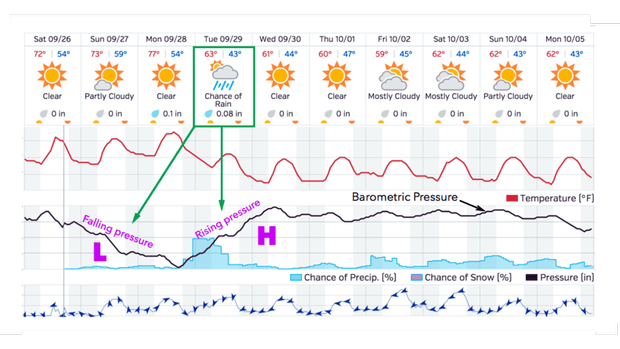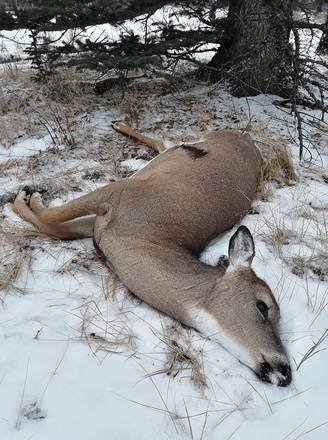On the long list of barstool deer hunting discussions is the correlation between deer hunting and weather, to take it to the next level: barometric pressure and deer.
While many formal studies have been done about wildlife behavior, traits, movements, and otherwise, there has been an even longer period of man (or woman) hours in the field observing deer and taking notes.
In this article, we will dive into:
Keep reading:
What is Barometric Pressure?
Barometric pressure is also known as “atmospheric pressure.” As we travel to higher elevations, we see the air gets thinner and the pressure lower.
At ground level (although not as extreme), these pressures run in an occasional state of flux.
How it Works:
Barometric pressure is built by the weight of the air above it compounding, which is why at higher elevations, the pressure is less, as there is less air above it to force it down.
Changes in barometric pressure are one critical sign of impending weather changes.
You’ve likely seen on weather forecasts the low and high-pressure systems. These are tracked movements and patterns of atmospheric pressure.
Measurement:
This pressure is measured in units of inches of mercury, pascals, hectopascals, millibars, psi, or standardized to the unit “atmosphere.”
The pressure reading in this article will be based on inHg (inches of mercury), primarily used as the unit of measurement for air pressure within the US.
For reference: a standard/average air pressure reading is 29.92 inHg (also known as 1 atmosphere, 14.70 psi or 1013.25 millibars).

Via quiverapp.co
How Does It Affect Deer Movement?
Currently, there is no conclusive scientific evidence to state whether deer move more, less, or the same during periods of barometric pressure fluctuation.
Not enough consistent data has been able to collaborate to definitively state the effect it may have, given the number of variables at play.
However, let’s look into some of the data collected by hunters over the year, anecdotal or otherwise.
From hunting reports, it appears that the greater the barometric pressure, the greater the movement.

Via Outdoorlife
Best Barometric Pressure for Deer Hunting
On some occasions, there were found to be triple the amount of sighted deer at pressure levels from 30.00 to 30.40, compared to pressure levels below 30.00.
Deer will not usually do anything much out of the ordinary, apart from continuing to move through their different feed and drinking zones, staying active for longer periods than usual.
Many hunters will attest to this, including myself, given my personal hunting successes.
How To Use Barometric Pressure To Your Advantage:
Okay, so we know how barometric pressure works and what the deer are up to. How do we then translate that into better hunting odds?
Know Your Pressures:

Hunting community advice is to hunt periods where the barometric pressure is greater than the general average for that time of year.
Throughout the fall deer season, these averages can change, usually increasing as the winter approaches.
Barometric pressure of 30.10 may be above average during the early archery season but below average during the later rifle seasons.
Although you may still benefit from hunting a stabilized high barometric pressure, it appears the deer sense the changes in barometric pressure, which then kicks them into action.
Set Up in a Prime Area:

Similar to any other hunting time, you want to sneak into your hunting area unnoticed wherever possible.
During these times, deer will continue to move around the areas they usually frequent, but potentially a little more so than usual.
Action Camera is most likely the best bet when setting up between need zone areas, field edges, or other locations with a consistent trail.
Keep it in Context:
Barometric pressure may play a part in when and how deer move; however it is essential not to lose sight of the other major factors affecting deer behavior.
These factors include the rut, general weather conditions (such as wind and rain), pressure from hunters and predators, the location and status of food sources.
Historical Weather:
You can get records of historical weather and barometric pressure on sites such as www.timeanddate.com; which gives the ability to see monthly averages and changes on specific dates by the hour.
It allows the hunter to take notes in the field and relate them to the recorded weather to look for patterns of deer behavior.
How to navigate to historical data:

Further down the page, you have the option to click specific dates with hour-by-hour temperature, wind, humidity, and barometric pressure information.

From Experience:

The first deer I ever harvested came during a period of increasing barometric pressure.
It was late morning (around 11 am), and a cold snap was coming in, dropping from around 32 degrees Fahrenheit to under 10 degrees.
Historical weather reports show that from mid-morning to early afternoon, the barometric pressure had increased from 30.08 to 30.41 inHg.
During this period, the deer continued to be active past their usual bed-down time, giving a rare shooting opportunity that otherwise may not have presented itself.
Summary:
Barometric pressure and its effect on deer movement and hunting opportunities will continue to invite different feelings from different hunters.
Until the time comes that detailed scientific data is gathered, it may continue to be a topic of superstition, myth, or habit.
Humans have had a long history with hunting, and who is more committed and observant than the seasoned hunter.
Whether you agree with it or not, it may well be worth a look at the atmospheric pressure this upcoming deer season to see if you can make it work for you.
Whether coincidence or genius hunting strategy, you may end up with the buck of a lifetime.
Do you factor changing barometric pressure into your hunting strategy, or is it something you will now consider? Leave your comments below!
